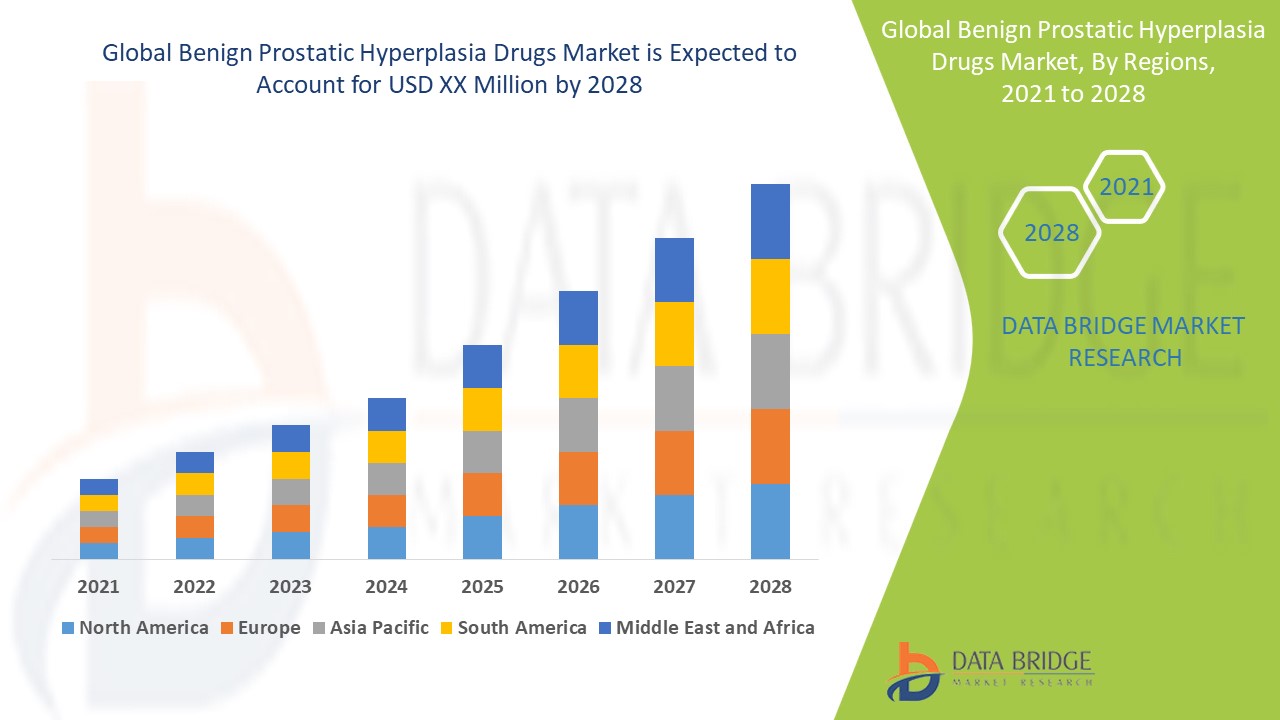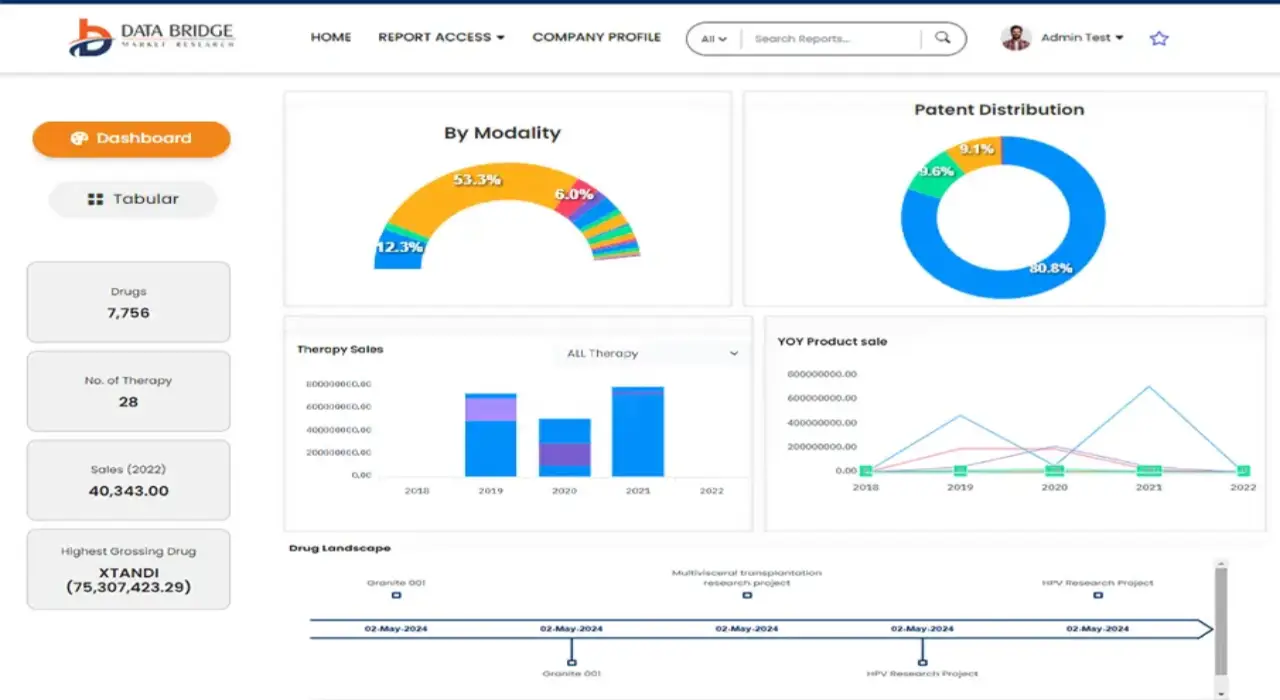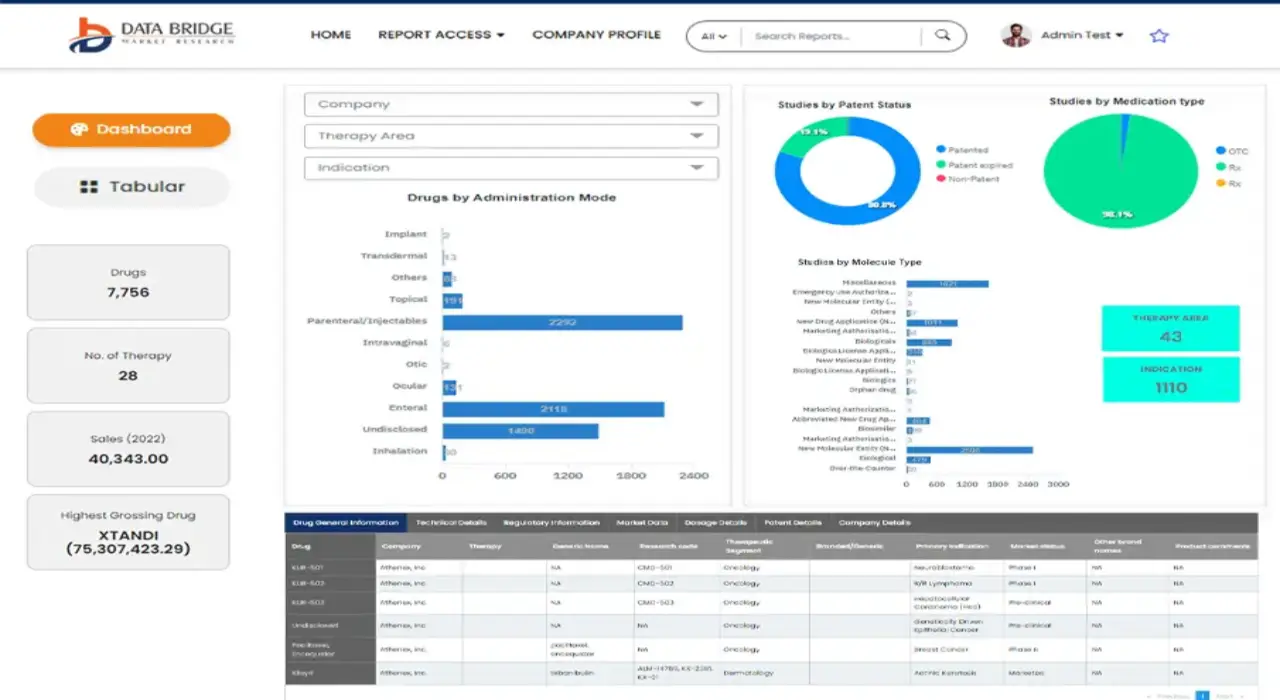Global Benign Prostatic Hyperplasia Drugs Market
Market Size in USD Billion
CAGR :
% 
 USD
6.36 Billion
USD
10.13 Billion
2024
2032
USD
6.36 Billion
USD
10.13 Billion
2024
2032
| 2025 –2032 | |
| USD 6.36 Billion | |
| USD 10.13 Billion | |
|
|
|
|
Global Benign Prostatic Hyperplasia Drugs Market Segmentation, By Drug Type (Alpha-Blockers, 5-Alpha Reductase Inhibitors, Alpha-Adrenergic Blockers, Phosphodiesterase Type-5 Inhibitors, Beta-Blockers, and Others), Treatment Type (Medication, Surgery, and Other), Dosage (Tablet, Capsule, and Others), Route of Administration (Oral and Others), End-Users (Clinic, Hospital, and Others), Distribution Channel (Hospital Pharmacy, Retail Pharmacy, and Online Pharmacy) – Industry Trends and Forecast to 2032
Benign Prostatic Hyperplasia Drugs Market Analysis
The benign prostatic hyperplasia drugs market is driven by the growing prevalence of benign prostatic hyperplasia in aging male populations worldwide. This condition is characterized by the enlargement of the prostate, causing urinary issues. Medications such as alpha-blockers, 5-alpha reductase inhibitors, and phosphodiesterase type-5 inhibitors are commonly used for managing symptoms. The market is witnessing significant growth due to the increasing demand for effective, minimally invasive treatments. Recent developments include the introduction of new drug formulations and combination therapies, which offer better symptom management with fewer side effects. The market is also being influenced by the rising awareness of the condition and the availability of advanced diagnostics, leading to earlier detection and treatment. With increasing research and development, the market is expected to continue expanding, driven by innovations and the aging global population. Emerging drugs and improved patient outcomes are likely to shape the future of the market.
Benign Prostatic Hyperplasia Drugs Market Size
The global benign prostatic hyperplasia drugs market size was valued at USD 6.36 billion in 2024 and is projected to reach USD 10.13 billion by 2032, with a CAGR of 6% during the forecast period of 2025 to 2032. In addition to the insights on market scenarios such as market value, growth rate, segmentation, geographical coverage, and major players, the market reports curated by the Data Bridge Market Research also include depth expert analysis, patient epidemiology, pipeline analysis, pricing analysis, and regulatory framework.
Benign Prostatic Hyperplasia Drugs Market Trends
“Rise of Combination Therapies”
The benign prostatic hyperplasia drugs market is experiencing significant growth, driven by the increasing prevalence of the condition among aging men. The market is evolving with continuous innovations aimed at providing better treatment outcomes. A notable trend is the rise of combination therapies, which combine different drug classes, such as alpha-blockers and 5-alpha reductase inhibitors, to enhance therapeutic effectiveness while minimizing side effects. This trend is gaining traction as it offers improved symptom management for patients. In addition, there is a growing emphasis on the development of minimally invasive treatments, fueled by advancements in drug delivery systems and patient preference for non-surgical options. The market's future is likely to be shaped by continued innovation in drug formulations and personalized treatments.
Report Scope and Benign Prostatic Hyperplasia Drugs Market Segmentation
|
Attributes |
Benign Prostatic Hyperplasia Drugs Key Market Insights |
|
Segments Covered |
|
|
Countries Covered |
U.S., Canada and Mexico, Germany, France, U.K., Netherlands, Switzerland, Belgium, Russia, Italy, Spain, Turkey, Rest of Europe, China, Japan, India, South Korea, Singapore, Malaysia, Australia, Thailand, Indonesia, Philippines, Rest of Asia-Pacific, Saudi Arabia, U.A.E., South Africa, Egypt, Israel, Rest of Middle East and Africa , Brazil, Argentina and Rest of South America |
|
Key Market Players |
AbbVie Inc. (U.S.), Astellas Pharma Inc. (Japan), Boehringer Ingelheim International GmbH (Germany), Eli Lilly and Company (U.S.), GSK plc (U.K.), Teva Pharmaceutical Industries Ltd. (Israel), Sanofi (France), Nymox Pharmaceuticals Corporation (U.S.), Novartis AG (Switzerland), Pfizer Inc. (U.S.), COSCIENS BIOPHARMA (Canada), IntelGenx Corp. (Canada), Bayer AG (Germany), Merck & Co., Inc. (U.S.), Ipsen Pharma (France), Bausch Health Companies Inc. (Canada), Quest PharmaTech Inc. (Canada), Bristol-Myers Squibb Company (U.S.), KAKEN PHARMACEUTICAL CO., LTD. (Japan), GemVax & KAEL Co., Ltd. (South Korea), and Kissei Pharmaceutical Co., Ltd. (Japan) |
|
Market Opportunities |
|
|
Value Added Data Infosets |
In addition to the insights on market scenarios such as market value, growth rate, segmentation, geographical coverage, and major players, the market reports curated by the Data Bridge Market Research also include depth expert analysis, patient epidemiology, pipeline analysis, pricing analysis, and regulatory framework. |
Benign Prostatic Hyperplasia Drugs Market Definition
Benign prostatic hyperplasia drugs are medications used to treat the symptoms of benign prostatic hyperplasia (BPH), a non-cancerous enlargement of the prostate gland that affects urinary function in men. These drugs work by either relaxing the muscles in the prostate and bladder neck (alpha-blockers), reducing the size of the prostate (5-alpha reductase inhibitors), or improving urinary flow (phosphodiesterase type-5 inhibitors). The goal of these medications is to alleviate symptoms such as frequent urination, difficulty in starting urination, and weak urine flow, improving quality of life for individuals suffering from this condition.
Benign Prostatic Hyperplasia Drugs Market Dynamics
Drivers
- Rising Minimally Invasive Treatment Options
The growing preference for non-surgical, minimally invasive surgery options is significantly boosting the demand for pharmacological solutions in the benign prostatic hyperplasia drugs market. Many patients are opting for medications over surgery due to the reduced risk, lower costs, and shorter recovery times associated with drug treatments. Pharmacological solutions, such as alpha-blockers, 5-alpha reductase inhibitors, and combination therapies, offer effective symptom management without the need for invasive procedures. This shift towards non-surgical treatments is a key market driver, as patients prioritize convenience and safety, leading to increased drug consumption and growing demand for innovative therapies in the market.
- Innovations in Drug Development
Innovations in drug development, such as combination therapies and extended-release formulations, are playing a significant role in improving patient outcomes and driving growth in the benign prostatic hyperplasia drugs market. Combination therapies, which blend different drug classes, provide more comprehensive symptom relief while minimizing side effects, offering patients a more effective treatment option. In addition, extended-release formulations allow for more convenient dosing schedules, improving patient adherence and long-term treatment efficacy. These advancements enhance the quality of life for patients and contribute to the growing demand for advanced pharmacological solutions, making innovation a key driver in the market’s expansion.
Opportunities
- Rise in Healthcare Access and Awareness
The rise in healthcare access and awareness in emerging economies presents a significant growth opportunity for the benign prostatic hyperplasia drugs market, particularly in regions such as Asia-Pacific, Latin America, and the Middle East. As these regions experience improvements in healthcare infrastructure and an increase in the number of healthcare facilities, more patients are being diagnosed and treated for benign prostatic hyperplasia. In addition, growing awareness of the condition and available treatments is driving the demand for drugs. This expanding patient pool, combined with rising disposable incomes and better healthcare access, offers substantial market potential for pharmaceutical companies to capitalize on.
- Advancements in Personalized Medicine
Advancements in personalized medicine, particularly through genetic testing and biomarker testing, present a significant market opportunity in the benign prostatic hyperplasia drugs market. By using these tests, healthcare providers can tailor treatments based on individual patient profiles, improving the efficacy and safety of therapies. This approach can lead to more targeted and effective drug options, reducing the risk of adverse effects and optimizing treatment outcomes. As personalized medicine continues to gain traction, pharmaceutical companies have the opportunity to develop drugs that cater to specific genetic markers, expanding their market reach and meeting the growing demand for customized healthcare solutions.
Restraints/Challenges
- Competition from Surgical Alternatives
Despite the growing preference for non-invasive treatments, surgical procedures such as transurethral resection of the prostate (TURP) remain common, posing a significant challenge to the benign prostatic hyperplasia drugs market. TURP is considered the gold standard for more severe cases of benign prostatic hyperplasia, offering immediate and effective symptom relief. As a result, many patients, especially those with advanced stages of the condition, may still opt for surgical intervention over pharmacological solutions. This continued reliance on surgical treatments presents competition for drug therapies, limiting the market share of pharmaceutical solutions and creating a barrier to the widespread adoption of non-invasive drug options.
- High Treatment Costs
The high cost of advanced treatments, particularly combination therapies and newer drug formulations, presents a significant restraint for the benign prostatic hyperplasia drugs market. These treatments, while often more effective, come with higher price tags, making them less accessible to patients, especially in low-income regions. In these areas, affordability becomes a critical issue, as many patients may not be able to access or afford the latest medications, leading to reliance on older, less effective, and often more invasive treatments. This financial barrier limits market growth, as a large portion of the patient population remains underserved due to cost constraints.
This market report provides details of new recent developments, trade regulations, import-export analysis, production analysis, value chain optimization, market share, impact of domestic and localized market players, analyses opportunities in terms of emerging revenue pockets, changes in market regulations, strategic market growth analysis, market size, category market growths, application niches and dominance, product approvals, product launches, geographic expansions, technological innovations in the market. To gain more info on the market contact Data Bridge Market Research for an Analyst Brief, our team will help you take an informed market decision to achieve market growth.
Benign Prostatic Hyperplasia Drugs Market Scope
The market is segmented on the basis of drug type, treatment type, dosage, route of administration, end-users, and distribution channel. The growth amongst these segments will help you analyse meagre growth segments in the industries and provide the users with a valuable market overview and market insights to help them make strategic decisions for identifying core market applications.
Drug Type
- Alpha-Blockers
- 5-Alpha Reductase Inhibitors
- Alpha-Adrenergic Blockers
- Phosphodiesterase Type-5 Inhibitors
- Beta-Blockers
- Others
Treatment Type
- Medication
- Surgery
- Other
Dosage
- Tablet
- Capsule
- Others
Route of Administration
- Oral
- Others
End-Users
- Clinic
- Hospital
- Others
Distribution Channel
- Hospital Pharmacy
- Retail Pharmacy
- Online Pharmacy
Benign Prostatic Hyperplasia Drugs Market Regional Analysis
The market is analysed and market size insights and trends are provided by country, drug type, treatment type, dosage, route of administration, end-users, and distribution channel as referenced above.
The countries covered in the market report are U.S., Canada and Mexico, Germany, France, U.K., Netherlands, Switzerland, Belgium, Russia, Italy, Spain, Turkey, rest of Europe, China, Japan, India, South Korea, Singapore, Malaysia, Australia, Thailand, Indonesia, Philippines, rest of Asia-Pacific, Saudi Arabia, U.A.E., South Africa, Egypt, Israel, rest of Middle East and Africa , Brazil, Argentina and rest of South America.
North America dominates the benign prostatic hyperplasia drugs market, driven by the presence of key pharmaceutical companies and a growing geriatric and obese population. The region benefits from a well-established healthcare infrastructure, ample research funding, and a higher awareness of health-related issues. In addition, the rising prevalence of benign prostatic hyperplasia in this population further fuels market growth.
The Asia-Pacific and European regions are projected to experience significant growth during the forecast period, driven by increasing research and development efforts and rising investments in healthcare. Growing disposable incomes and large population bases also contribute to the demand for benign prostatic hyperplasia treatments. In addition, government initiatives aimed at raising awareness about the condition and its available treatments are expected to further support market growth in these regions.
The country section of the report also provides individual market impacting factors and changes in regulation in the market domestically that impacts the current and future trends of the market. Data points such as down-stream and upstream value chain analysis, technical trends and porter's five forces analysis, case studies are some of the pointers used to forecast the market scenario for individual countries. Also, the presence and availability of global brands and their challenges faced due to large or scarce competition from local and domestic brands, impact of domestic tariffs and trade routes are considered while providing forecast analysis of the country data.
Benign Prostatic Hyperplasia Drugs Market Share
The market competitive landscape provides details by competitor. Details included are company overview, company financials, revenue generated, market potential, investment in research and development, new market initiatives, global presence, production sites and facilities, production capacities, company strengths and weaknesses, product launch, product width and breadth, application dominance. The above data points provided are only related to the companies' focus related to market.
Benign Prostatic Hyperplasia Drugs Market Leaders Operating in the Market Are:
- AbbVie Inc (U.S.)
- Astellas Pharma Inc. (Japan)
- Boehringer Ingelheim International GmbH (Germany)
- Eli Lilly and Company (U.S.)
- GSK plc (U.K.)
- Teva Pharmaceutical Industries Ltd. (Israel)
- Sanofi (France)
- Nymox Pharmaceuticals Corporation (U.S.)
- Novartis AG (Switzerland)
- Pfizer Inc. (U.S.)
- COSCIENS BIOPHARMA (Canada)
- IntelGenx Corp. (Canada)
- Bayer AG (Germany)
- Merck & Co., Inc. (U.S.)
- Ipsen Pharma (France)
- Bausch Health Companies Inc. (Canada)
- Quest PharmaTech Inc. (Canada)
- Bristol-Myers Squibb Company (U.S.)
- KAKEN PHARMACEUTICAL CO., LTD. (Japan)
- GemVax & KAEL Co., Ltd. (South Korea)
- Kissei Pharmaceutical Co., Ltd. (Japan)
Latest Developments in Benign Prostatic Hyperplasia Drugs Market
- In April 2024, Takeda Pharmaceutical Company Limited (TSE: 4502/NYSE: TAK, President and CEO; Christophe Weber, “Takeda”), Astellas Pharma Inc. (TSE: 4503, President and CEO: Naoki Okamura, “Astellas”), and Sumitomo Mitsui Banking Corporation (President & CEO: Akihiro Fukutome, “SMBC”) today announced that the three companies signed a master agreement on April 22, 2024, to establish a joint venture company. The new company will be dedicated to the incubation*1 of early drug discovery programs, primarily originating from Japan and toward the creation of innovative therapeutics
- In February 2024, EMS released findings from a Phase III clinical trial evaluating the efficacy and safety of DTT106 for treating erectile dysfunction linked to benign prostatic hyperplasia. This trial was conducted across multiple centers, adhering to a randomized and double-blind design. The results highlighted DTT106's potential in addressing this dual condition effectively and safely
- In February 2024, Resurge Therapeutics Inc. unveiled findings from a dose-escalation study assessing the safety and feasibility of RT-310 for treating lower urinary tract symptoms caused by benign prostatic hyperplasia. The study aimed to evaluate the therapeutic potential and tolerability of RT-310 in this condition. Results demonstrated promising outcomes, supporting further research and development efforts
- In April 2022, Teleflex introduced the UroLift System in Japan to treat benign prostatic hyperplasia (BPH). This system had previously received FDA approval for addressing lower urinary tract symptoms caused by BPH. The launch marks a significant step in expanding the availability of this minimally invasive treatment option to a broader patient population in Japan
- In October 2020, Astellas Pharma Inc. and Takeda Pharmaceutical Company Limited announced a merger, expected to be finalized in 2023. The strategic partnership aims to create a global leader in developing and marketing innovative therapies for benign prostatic hyperplasia (BPH). This merger is set to enhance both companies' capabilities in addressing the growing demand for effective BPH treatments worldwide
SKU-
Get online access to the report on the World's First Market Intelligence Cloud
- Interactive Data Analysis Dashboard
- Company Analysis Dashboard for high growth potential opportunities
- Research Analyst Access for customization & queries
- Competitor Analysis with Interactive dashboard
- Latest News, Updates & Trend analysis
- Harness the Power of Benchmark Analysis for Comprehensive Competitor Tracking
Research Methodology
Data collection and base year analysis are done using data collection modules with large sample sizes. The stage includes obtaining market information or related data through various sources and strategies. It includes examining and planning all the data acquired from the past in advance. It likewise envelops the examination of information inconsistencies seen across different information sources. The market data is analysed and estimated using market statistical and coherent models. Also, market share analysis and key trend analysis are the major success factors in the market report. To know more, please request an analyst call or drop down your inquiry.
The key research methodology used by DBMR research team is data triangulation which involves data mining, analysis of the impact of data variables on the market and primary (industry expert) validation. Data models include Vendor Positioning Grid, Market Time Line Analysis, Market Overview and Guide, Company Positioning Grid, Patent Analysis, Pricing Analysis, Company Market Share Analysis, Standards of Measurement, Global versus Regional and Vendor Share Analysis. To know more about the research methodology, drop in an inquiry to speak to our industry experts.
Customization Available
Data Bridge Market Research is a leader in advanced formative research. We take pride in servicing our existing and new customers with data and analysis that match and suits their goal. The report can be customized to include price trend analysis of target brands understanding the market for additional countries (ask for the list of countries), clinical trial results data, literature review, refurbished market and product base analysis. Market analysis of target competitors can be analyzed from technology-based analysis to market portfolio strategies. We can add as many competitors that you require data about in the format and data style you are looking for. Our team of analysts can also provide you data in crude raw excel files pivot tables (Fact book) or can assist you in creating presentations from the data sets available in the report.













